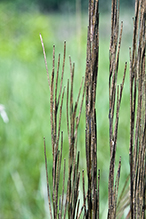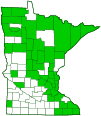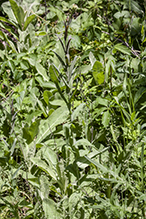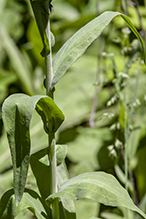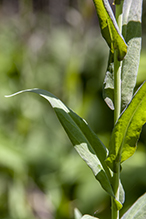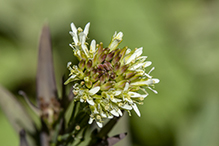tower mustard
(Turritis glabra)
Conservation • Description • Habitat • Ecology • Use • Distribution • Taxonomy
Conservation Status |
|
|||||||
| IUCN Red List | not listed |
|||||||
| NatureServe | N3N5 - Vulnerable to Secure SNR - Unranked |
|||||||
| Minnesota | not listed |
|||||||
Description |
||
Tower mustard is a 12″ to 60″ tall, erect, biennial or short-lived perennial forb that rises on one or more stems from a stout taproot. In the first year the plant produces a rosette of basal leaves. These leaves are green or grayish green, up to 1½″ long, ¾″ wide, and inversely lance-shaped, with the attachment at the narrow end. The margins have outward-pointing teeth and shallow lobes. The upper surface is hairy, becoming less hairy with age. One or more stems are produced in the second year. They are erect, usually unbranched, sometimes forked, leafy, and hairy near the base; hairless, light green and covered with a whitish, waxy coating (glaucous) above. Stem leaves are alternate, overlapping near the base, less so above. They are up to 3″ long and 1″ wide, grayish-green, lance-shaped, hairless, and glaucous. A pair of lobes at the base of the leaf blade clasps the stem. Middle and upper stem leaves are untoothed. Lower stem leaves are toothed, slightly lobed, and commonly have Y-shaped hairs. The inflorescence is an tight, short cluster at the end of the stem. The flowers are ¼″ to ½″ wide. The 4 petals are white. The fruit is an upward pointing, 2″ to 3½″ long, narrow, almost cylindrical pod that is roundish in cross-section. The fruits develop below the inflorescence. |
||
Height |
||
12″ to 60″ |
||
Flower Color |
||
White |
||
Similar Species |
||
Habitat |
||
Dry. Prairies, fields. Full sun. |
||
Ecology |
||
Flowering |
||
May to June |
||
Defense Mechanisms |
||
This and other mustards (family Brassicaceae) produce chemical compounds when cells are damaged that are toxic to most animals, fungi, and bacteria. |
||
Pests and Diseases |
||
|
||
Use |
||
|
||
Distribution |
||||
|
Sources |
|||
| 7/25/2023 | ||||
Nativity |
||||
Native |
||||
Occurrence |
||||
|
||||
Taxonomy |
|||
| Kingdom | Plantae (Plants) | ||
| Division | Tracheophyta (Vascular Plants) | ||
| Subdivision | Spermatophytina (Seed Plants) | ||
| Class | Magnoliopsida (Dicots) | ||
Order |
Brassicales (mustards, capers, and allies) | ||
Family |
Brassicaceae (mustard) | ||
| Subfamily | Brassicoideae | ||
| Supertribe | Camelinodae | ||
| Tribe | Thlaspideae | ||
Genus |
Turritis (tower mustards) | ||
Tower mustard was placed with one other species in the genus Turritis when it was first described by Carl Linnaeus in 1753. In 1772, Giovanni Antonio Scopoli moved the second species to the genus Arabis based on seed arrangement, leaving Turritis with a single species. In 1783, Jean-Baptiste Lamarck transferred tower mustard to the genus Arabis with the new species name Arabis perfoliata. In 1800, Johann Jakob Bernhardi corrected the classification, renaming it Arabis glabra. In 2009, Koch et al. transferred it back to Turritis based on DNA analysis. |
|||
Subordinate Taxa |
|||
|
|||
Synonyms |
|||
Arabis glabra Arabis glabra var. furcatipilis Arabis glabra var. glabra |
|||
Common Names |
|||
tower mustard tower-mustard tower rockcress |
|||
Glossary
Clasping
Describing a leaf that wholly or partly surrounds the stem but does not fuse at the base.
Glaucous
Pale green or bluish gray due to a whitish, powdery or waxy film, as on a plum or a grape.

Slideshows |
||

Visitor Videos |
|||
Share your video of this plant. |
|||
| This button not working for you? Simply email us at info@MinnesotaSeasons.com. Attach a video, a YouTube link, or a cloud storage link. |
|||
Other Videos |
|||

Visitor Sightings |
|||||
Report a sighting of this plant. |
|||||
| This button not working for you? Simply email us at info@MinnesotaSeasons.com. Be sure to include a location. |
|||||
|
|||||
MinnesotaSeasons.com Sightings |
|||||

|
Created: Last Updated: © MinnesotaSeasons.com. All rights reserved. |
